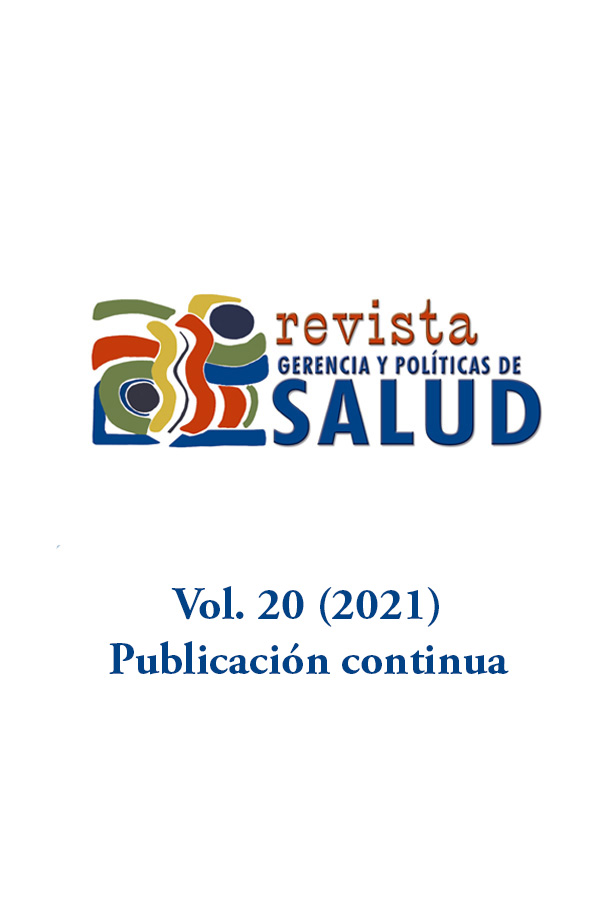Characterization of the COVID-19 trend in Colombia with polynomial regressions
##plugins.themes.bootstrap3.article.details##
Objective. To develop a series of polynomial models to track the growth and trend of infection and death curve for COVID-19 in Colombia. Methods. The infected and daily deaths from COVID-19 between March 6 to April 10, 2021, were used. For its prediction analysis, we use polynomial functions in Excel. Results. Of the six polynomial functions evaluated, the polynomial with the highest level of determination is that of degree 6 according to the adjusted R2. Predictions were made taking into account the accumulated polynomial functions of confirmed infected and deceased. Conclusions. Easy-to-build Excel models such as polynomial functions are effective for monitoring public health events, facilitating timely decision-making.
Coronavirus infections, epidemiology, pandemics, transmission, severe acute respiratory syndromeInfecções por coronavírus, epidemiologia, pandemias, transmissão, síndrome respiratória aguda graveInfecciones por corovarovirus, epidemiologia, pandemias, transmisión, síndrome respiratorio agudo grave
2. Paredes Y, Chipia J. COVID-19: estadística de morbi-mortalidad en Venezuela. GICOS: Revista del Grupo de Investigaciones en Comunidad y Salud. 2020;5(2):47-66. http://erevistas.saber.ula.ve/index,php/gicos/article/view/16120
3. Fong S, Li G, Dey N, Crespo R, Herrera-Viedma E. Finding an accurate early forecasting model from small dataset: A case of 2019-nCoV novel coronavirus outbreak. Preprint. 2020;2003.10776. http://dx.doi.org/ijimai.2020.02.002
4. Bertozzi A, Franco E, Mohler G, Short M, Sledge D. The challenges of modeling and forecasting the spread of COVID-19. Preprint. 2020;2004.04741. http://dx.doi.org/10.1073/pnas.2006520117
5. Li L, Yang Z, Dang Z, Meng C, Huang J, Meng H, et al. Propagation analysis and prediction of the COVID-19. Infectious Disease Modelling. 2020;5:282-292. https://doi.org/10.1016/j.idm.2020.03.002
6. Mizumoto K, Chowell G. Transmission potential of the novel coronavirus (COVID-19) onboard the Diamond Princess Cruises Ship, 2020. Infectious Disease Modelling. 2020;5:264-270. https://doi.org/10.1016/j.idm.2020.02.003
7. Hernandez-Matamoros A, Fujita H, Hayashi T, Perez-Meana H. Forecasting of COVID19 per regions using ARIMA models and polynomial functions. Applied Soft Computing. 2020;96:106610. http://dx.doi.org/10.1016/j.asoc.2020.106610
8. Benvenuto D, Giovanetti M, Vassallo L, Angeletti S, Ciccozzi M. Application of the ARIMA model on the COVID-2019 epidemic dataset. Data in brief. 2020;(29):105340. http://dx.doi.org/10.1016/j.dib.2020.105340
9. Manrique F, González-Chordá V, Gutiérrez O, Tellez C, Herrera-Amaya G. Modelo SIR de la pandemia de Covid-19 en Colombia. Revista Salud Pública Universidad Nacional. 2020;22:1-9. http://dx.doi.org/10.15446/rsap.v22n2.85977
10. Bizet N, Pena D. Time-dependent and time-independent SIR models applied to the COVID-19 outbreak in Argentina, Brazil, Colombia, Mexico and South Africa. 2006.12479. arXiv preprint arXiv:2006.12479. https://arxiv.org/pdf/2006.12479.pdf
11. Golondrino G, Muñoz WML. Aplicación de la regresión polinomial para la caracterización de la curva del COVID-19 en Colombia, mediante técnicas de machine learning. Investigación e Innovación en Ingenierías. 2020;8(2);87-105. http://dx.doi.org/10.17081/invinno.8.2.4103
12. Pinzón J. Proyección de la propagación del COVID-19 en Colombia. Revista Med de la Facultad de Medicina. 2020;28(1):11-20. http://dx.doi.org/10.18359/rmed.4702
13. Arango-Londoño D, Ortega-Lenis D, Muñoz E, Cuartas D, Caicedo D, Mena J, et al. Predicciones de un modelo SEIR para casos de COVID-19 en Cali, Colombia. Rev Salud Públ. 2020;22:1-6. https://doi.org/10.15446/rsap.V22n2.86432
14. Montesinos-López, Hernández-Suárez. Modelos matemáticos para enfermedades infecciosas. Salud Públ Méx. 2007;49(3):218-226. http://dx.doi.org/10.1590/S0036-36342007000300007
15. Heras, Donado, Pachón. Métodos cuantitativos y análisis epidemiológico en vigilancia. Vigilancia Epidemiológica de Navarra. Madrid: McGraw-Hill Interamericana; 2004.
16. Ferretti L, Wymant C, Kendall M, Zhao L, Nurtay A, Abeler-Dörner L, et al. Quantifying SARS-CoV-2 transmission suggests epidemic control with digital contact tracing. Science. 2020;368(6491). http://dx.doi.org/10.1126/science.abb6936
17. Kucharski A, Russell T, Diamond C, Liu Y, Edmunds J, Funk S, et al. Early dynamics of transmission and control of COVID-19: A mathematical modelling study. The lancet infectious diseases. 2020;20(5):553-558. http://dx.doi.org/10.1016/S1473-3099(20)30144-4
18. da Rocha A. Regression Polynomial Analysis of the COVID-19 Epidemics: Some Initial Findings; 2020. http://dx.doi.org/10.2139/ssrn.3636820
19. Avendaño V. Infección del Covid-19 en Colombia. Una comparación de modelos logísticos y exponenciales aplicados a la infección por el virus en Colombia; 2020. https://www.researchgate.net/publication/340092755_Infeccion_del_Covid-19_en_Colombia_Una_comparacion_de_modelos_logisticos_y_exponenciales_aplicados_a_la_infeccion_por_el_virus_en_Colombia
20. Martínez J, Vargas A. Covid-19: evolución y estimaciones de las curvas epidémicas; 2020. http://bibliodigitalibd.senado.gob.mx/bitstream/handle/123456789/4877/Reporte%20TE%2078%20Curvas%20epidemicas%20F.pdf?sequence=1
21. Gerli A, Centanni S, Miozzo M, Sotgiu G. Predictive models of COVID-19 Related deaths and infections. Int J Tuberc Lung Dis. 2020;24:10. http://dx.doi.org/10.5588/ijtld.20.0196
22. Bravo A, Vera M, Huérfano YK. Modelos matemáticos estimadores de la infección por COVID-19: consideraciones esenciales y proyecciones en Colombia. Rev Salud Public. 2020;22(3):1-7. https://doi.org/10.15446/rsap.V22n3.87813
23. Cagigal M, Becario F. Modelado y análisis de la evolución de una epidemia vírica mediante filtros de Kalman: el caso de la COVID-19 en España. Depósito de investigación de la Universidad de Sevilla. España: Universidad de Sevilla. 2020. https://idus.us.es/bitstream/handle/11441/94508/Analisis%20de%20la%20evolucion%20del%20COVID-19%20con%20Filtros%20de%20Kalman%20v1%20%2801-04-2020%29.pdf?sequence=7&isAllowed=yLo guarde pdf

This work is licensed under a Creative Commons Attribution 4.0 International License.


